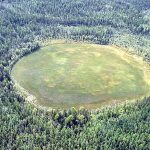Key Takeaways:
- A groundbreaking 3D map of the Milky Way, created using data from over 2,400 pulsing stars, reveals the galaxy’s warped shape.
- This study challenges the notion of the Milky Way as a flat, featureless structure, showcasing a wave-like distortion.
- The research sheds light on the galaxy’s history, potentially offering a better understanding of our cosmic position.
- The study focused on Cepheids, young stars that serve as cosmic calipers due to their predictable luminosity changes.
- The Milky Way’s contorted form, resembling a sideways ‘S’, starts about 25,000 light-years from the center, with an extreme warp at 35,000 light-years.
In a revelation that challenges our conventional understanding of the Milky Way, a team of astronomers has unveiled a groundbreaking 3D map of our galaxy. Drawing on the positions of over 2,400 pulsing stars, including those from the outer fringes, this stellar atlas provides one of the most comprehensive depictions of the Milky Way to date.
Published in the journal Science, the research discloses that the Milky Way isn’t the flat expanse we often envision; rather, it exhibits a warp akin to a beach towel shaken free of sand. This fresh perspective may not only rewrite our perception of the galaxy but also offer crucial insights into its enigmatic history, offering a more profound sense of our cosmic location.
For decades, scientists have suspected a subtle bending in the Milky Way’s structure. Initial observations of hydrogen gas in the 1950s hinted at fraying edges, a notion supported by later studies exploring various cosmic elements. However, confirming this warp posed a formidable challenge due to our Earth-bound vantage point.
Kathryn Johnston, an astronomer at Columbia University, aptly likened the task to tracing a forest’s outline from its center. While the possibility of an extragalactic telescope looms on the horizon, the team, led by Dorota Skowron from the University of Warsaw, opted for a more immediate approach—tracking a trail of stellar breadcrumbs scattered across the Milky Way.
Central to the study were the Cepheids, youthful stars outshining the Sun by up to 100,000 times, rendering them detectable from thousands of light-years away. Their predictable luminosity fluctuations make them cosmic calipers, enabling the calculation of absolute brightness and subsequent placement on a cosmic map.
Through the Optical Gravitational Lensing Experiment (OGLE), Skowron and her colleagues scrutinized over 1,500 Cepheids across the Milky Way, amassing an astounding 154 billion astronomical observations over six years. Complemented by data on 900 additional Cepheids from other catalogs, the stars painted a comprehensive picture spanning the galaxy.
The resulting 3D map represents an unparalleled visualization of the Milky Way, portraying it as a cosmic contortionist—a sideways ‘S’ with a solitary peak and valley. The warp initiates approximately 25,000 light-years from the galactic center, culminating in an extreme distortion at the outer edges, another 35,000 light-years distant.
Notably, some of the farthest stars reside approximately 5,000 light-years above or below the galactic plane, yielding an average 8 percent grade from center to edge. Additionally, the model exposes a peculiar thickening of the Milky Way’s edges compared to its center, resulting in a bowtie-like flare when viewed from the side.

These revelations corroborate a similar study published earlier in Nature Astronomy, yet this latest map benefits from a substantially larger sample of Cepheids. While the findings may not be entirely surprising, they signify a significant advancement in our understanding of the Milky Way’s structure.
The galaxy’s warped form aligns it with the norm, as half of all spiral galaxies exhibit some degree of distortion. The origins of these contortions remain speculative, ranging from gravitational tugging by inner stars to remnants of past galactic collisions.

However, this galactic mapping journey is far from complete. The concentration of dust at the Milky Way’s core hampers visibility of stars on the far side, and most Cepheids observed in the study cluster on the same side as our Solar System. Hence, certain areas of the map possess sparser data. To compensate, insights from dust, gas, and other star types offer complementary perspectives, emphasizing the complexity of understanding a galaxy as vast and intricate as the Milky Way.
Considering the enormity of our galaxy, the characterized Cepheids, though numerous, represent only a fraction of its celestial expanse. Yet, this underscores the imperative to persevere in our exploration. As Debra Elmegreen of Vassar College points out, “we’ve got the whole sky available,” suggesting that there may be more revelations awaiting discovery beyond the stars we’ve already charted.


